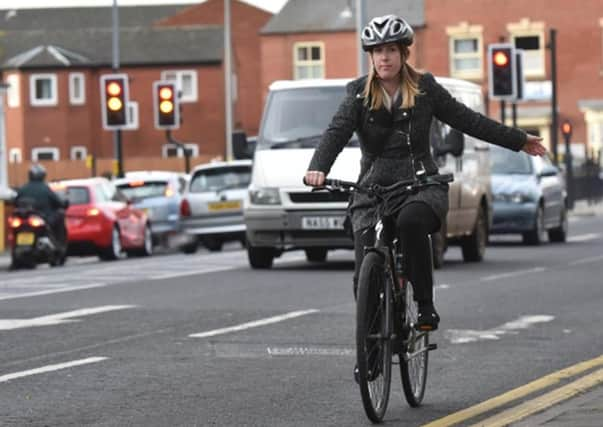New data spells out urgent need for investment in walking and cycling in Peterborough area


The drop is from figures taken in 2018 and then 2019, with the number of primary school children walking to school down by the same amount - from 51 per cent in 2018 to 47 per cent in 2019.
In Peterborough, 78.4 per cent of people surveyed did any walking or biking at least once a month in 2018-19, compared to a Cambridgeshire average of 83.4 per cent. That percentage for the city dropped to 69.8 per cent for those biking or walking once a week (75.7% for Cambridgeshire).
Advertisement
Hide AdAdvertisement
Hide AdOnly half the city (50.8%) biked or walked three times a week (53.7% for the county); and that figure dropped to 38.6 per cent for those in the city who did it five times a week (41.3% for the county).
Living Streets, the UK charity for everyday walking, calls on the Government to set aside part of the committed £2bn for walking and cycling for successful behaviour-change programmes and infrastructure which supports more walking journeys.
The Government’s Walking and Cycling Plan which was released last week has highlighted its ambition to increase walking and cycling journeys to improve fitness and health levels in the nation and fight off the effects of coronavirus. The latest National Travel Survey data shows how timely the need for ‘Gear Change’ is and the need to put pedestrians at the top of the travel hierarchy.
Jenni Wiggle, Interim Chief Executive at Living Streets said: “The latest National Travel Survey stats show how necessary investment in walking and cycling is. Many of us have come to value the mental and physical health benefits offered by a daily walk since the COVID-19 pandemic unfolded. As the Government told us to avoid nonessential travel during lockdown, we were all forced to consider whether each car journey was necessary or not. And it turned out, many weren’t. “Alongside the many infrastructure changes happening across the country, it’s vital more investment is given to behaviour-change programmes, especially at this time when many of us appreciate walking more, to inspire us all to add walking to our daily lives. The 2019 NTS figures show many of us are still not walking enough local, everyday journeys.”
Advertisement
Hide AdAdvertisement
Hide AdParticularly concerning statistics, released as part of this year’s NTS data, is the drop in walk to school rates. This is the second drop in walking to school levels over recent years, and with a quarter of cars on the road at morning peak, on the school run – it is seen as vital that we increase walking levels among primary school families. Living Streets’ WOW, year-round Walk to School Challenge resulted in 23 per cent more children walking to primary school, on average, and 30 per cent fewer cars driving up the school gates.
Ms Wiggle continues: “Just 47 per cent of all walking trips completed last year weren’t for leisure purposes. Embedding walking as a mode of everyday travel from a young age is vital. We want to see more investment in behaviour-change programmes, like WOW.”
Also released today is the National Travel Attitudes Survey. This highlights the public’s concerns over air quality and road safety with half concerned about both (48% and 54% respectively).
Ms Wiggle continues: “We want to enable people to travel in healthier and more sustainable ways. Reducing private car use is vital if we’re to tackle the urgent climate emergency and create stronger, healthier and less polluted communities. That’s why it is vital to harness this newfound realisation people are having that the private car doesn’t have to be at the heart of our communities.
Advertisement
Hide AdAdvertisement
Hide Ad“The improvements made by governments across the UK are encouraging – low traffic neighbourhoods, school streets, reallocation of road space to walking and cycling – are absolutely essential to tackling these crises for the long term.
“At Living Streets, we fully support plans to encourage more walking and cycling. As part of the package of measures, the Government has launched a consultation on its proposed revisions to the Highway Code – applicable across England, Scotland and Wales – to make it safer for people walking and cycling. It’s important people take part in this consultation to make walking number one.”
The charity maintains that walking significantly reduces the risk of health conditions like heart disease and diabetes. By switching from unnecessary short car journeys, walking can help reduce air pollution, which is currently costing the UK economy £157 million every year. When asked in the attitudinal survey, 59 per cent said they were walking more for health reasons.
The Government’s Obesity Strategy focuses on green prescriptions which are going to be important in encouraging people to get more active. Walking is the easiest and most accessible form of physical activity.
Living Streets is part of the Walking and Cycling Alliance which is urging the Government to commit to funding significant improvements in active travel.
Comment Guidelines
National World encourages reader discussion on our stories. User feedback, insights and back-and-forth exchanges add a rich layer of context to reporting. Please review our Community Guidelines before commenting.